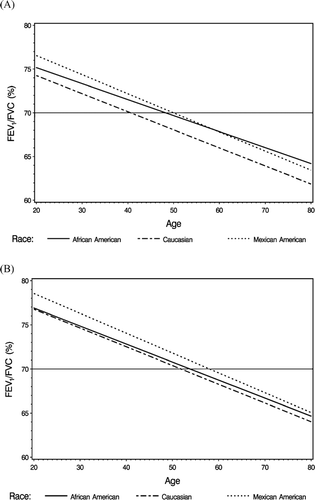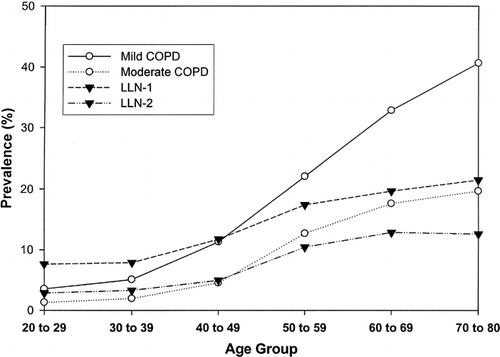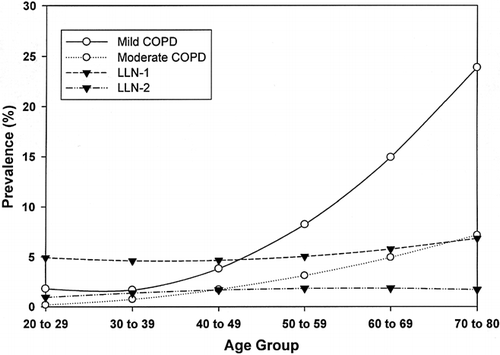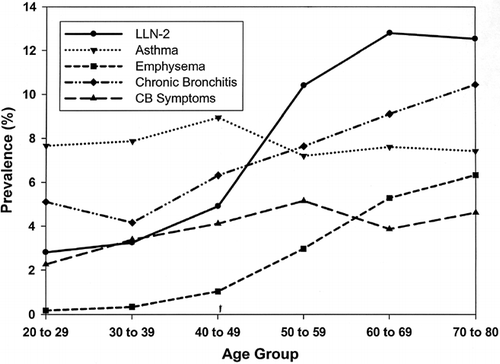Abstract
The objective of this study was to evaluate the definitions for classification of chronic obstructive pulmonary disease (COPD) recommended by the American Thoracic Society (ATS) and the Global Initiative for Chronic Obstructive Lung Disease (GOLD). Using data from the U.S. population-based third National Health and Nutrition Examination Survey (NHANES III), we compared the number of individuals in the U.S. population who met definitions of airflow obstruction based on the fixed ratio of FEV1/FVC < 0.70 criterion and on the ATS lower 95% confidence limit (lower limits of normal LLN) criterion. Further, we evaluated the definitions in the context of physician-diagnosed obstructive airways diseases and respiratory symptoms. In comparison to the FEV1/FVC < LLN and FEV1 < 100% predicted definition, the fixed ratio-based definition for mild COPD underestimates airflow obstruction by 29% in 20–49-year-olds and overestimates it by 58% in 50–80-year-olds. In comparison to the FEV1/FVC < LLN and FEV1 < LLN definition, the fixed ratio-based definition for moderate COPD underestimates airflow obstruction by 31% in 20–49-year-olds and overestimates it by 37% in 50–80 year olds. Based on our estimation, approximately 0.9 million (26%) of symptomatic individuals out of the 3.6 million U.S. adults aged 20–49 years who have airflow obstruction (FEV1/FVC < LLN and FEV1 < LLN definition) may have undiagnosed respiratory disease. In conclusion, using the FEV1/FVC < 0.70 criterion will substantially under-diagnose airway obstruction in younger individuals and substantially over-diagnose COPD in older individuals.
INTRODUCTION
Chronic obstructive pulmonary disease (COPD) is an important cause of morbidity and mortality in the world (Citation[1]). Commonly used criteria for classification of airflow obstruction and COPD are those of the American Thoracic Society (ATS), European Respiratory Society (ERS), and the NHLBI/WHO Global Initiative for Chronic Obstructive Lung Disease (GOLD)(Citation[1], Citation[2], Citation[3], Citation[4]). All these criteria use the FEV1/FVC ratio to define airflow obstruction or COPD. The recent GOLD and ATS/ERS definitions use a post-bronchodilator fixed ratio of FEV1/FVC < 0.70 to define the presence of COPD and the FEV1 percent predicted to define disease severity (Citation[1], Citation[4]).
The rationale for a fixed ratio value of 0.70 is its simplicity. However, because the predicted FEV1/FVC ratio decreases with age (Citation[5], Citation[6], Citation[7]), using a fixed FEV1/FVC < 0.70 value instead of the age-defined LLN(Citation[2], Citation[3]) can result in under-diagnosis of COPD in younger individuals and over-diagnosis of COPD in older individuals. Although some studies have identified this issue (Citation[8], Citation[9], Citation[10]), none have evaluated the actual magnitude of this effect across a whole adult population. Such evaluation provides important data on potential risk of COPD in different population age-strata. illustrates how the fixed percent FEV1/FVC criterion of 70% cuts across the sex- and race/ethnic-specific normative LLN curves for FEV1/FVC estimated from NHANES III data (Citation[6]), causing potential misclassification when determining the prevalence of COPD.
Figure 1. Predicted lower 95% confidence limits (LLN) for FEV1/FVC (%), for males (A) and females (B), by race/ethnicity, based on NHANES III data6

We used NHANES III data to estimate and compare the U.S. age-specific prevalence and burden of airflow obstruction determined by the fixed ratio-based definitions and by the LLN-based definitions. We also estimated the U.S. age-specific prevalence of self-reported physician-diagnosed airways diseases and symptoms, and their association with airway obstruction, as measured by spirometry.
MATERIALS AND METHODS
Study subjects
We used the NHANES III data to estimate the U.S. population prevalences. The NHANES III was conducted from 1988 to 1994 by the National Center for Health Statistics (NCHS) to assess the health and nutritional status of the U.S. population (Citation[11]). NHANES III included a questionnaire and spirometry (without bronchodilator) that conformed to the ATS recommendations (Citation[12]). Lung function normative equations were published from NHANES III data using the results from the subset of healthy never-smokers who did not report any respiratory symptoms or diseases (Citation[6]).
The present study included subjects 20 to 80 years old (n = 17,287). We excluded 3,445 subjects because spirometry data were missing (2,510) or judged “unusable” (250), or the race/ethnicity was other than of the three groups for which we had normative equations (685) (ref. 6); 13,842 subjects remained in the analysis.
Case definitions for airflow obstruction
Predicted FEV1 and predicted FEV1/FVC (%) values and their LLN were calculated from sex-specific reference equations for Caucasians, African-Americans, and Mexican-Americans (Citation[6]). The LLN values were defined by the one-sided lower 95% confidence interval of the reference equations.
The following case definitions for COPD and airflow obstruction were used in our analysis:
COPD definitions based on a fixed ratio criteria:(Citation[1])
Mild COPD (GOLD Stage 1): FEV1/FVC < 70% and FEV1 ≥ 80% predicted.
Moderate COPD (GOLD Stage 2): FEV1/FVC < 70% and FEV1 < 80% predicted.
LLN-based definitions:(Citation[2])
LLN-1: FEV1/FVC < LLN and FEV1 < 100% predicted
LLN-2: FEV1/FVC < LLN and FEV1 < LLN (about 80% predicted).
Definition of physician-diagnosed diseases and respiratory symptoms
Positive responses to the three NHANES III questions: “Has a doctor ever told you that you had emphysema (or chronic bronchitis)(or asthma)?” were used to define self-reported physician-diagnosed emphysema, chronic bronchitis, and asthma.
Positive responses to questions on both cough and phlegm that persisted more than three months in a year over two years represented “symptoms of chronic bronchitis.” A positive response to “Are you troubled by shortness of breath when hurrying on level ground or walking up a slight hill?” and/or to “When you do not have a cold does your chest ever sound wheezy/whistling?” were combined together as symptoms of “shortness of breath and/or wheezing.”
Statistical data analysis
We used SUDAAN software to estimate U.S. population prevalences (Citation[13]). SUDAAN software adjusts for the sampling design in calculating the variance estimates and adjusts for the number of individuals in the population that each sampled individual represents.
RESULTS
Comparisons of the LLN- and fixed ratio-based definitions
compares the U.S. age-specific prevalences of Mild and Moderate COPD and of airflow obstruction as determined by the LLN-1 and LLN-2 criteria. The definitions for Mild and Moderate COPD yielded lower prevalences in younger subjects (20–49 years of age) and substantially higher prevalences in older subjects (50–80 years of age) than LLN-1 and LLN-2, respectively. By statistical design, all age-specific prevalences based on the FEV1/FVC < LLN are parallel to each other, reflecting increasing severity of impairment as defined by percent predicted FEV1.
Figure 2. U.S. age-specific prevalences of airflow obstruction based on the following definitions: LLN-1, LLN-2, Mild COPD and Moderate COPD, as estimated from NHANES III data

gives the age-specific prevalences and number of individuals as classified according to each definition, and the percentage by which the number of individuals classified by the COPD definitions differ from those of the LLN-based definitions. For mild airflow obstruction, an estimated 18 million (12%) individuals in the U.S. population had airflow obstruction based on LLN-1 (). In comparison to LLN-1, the number of individuals classified with Mild COPD was decreased by 29% in the 20–49 age category and increased by 58% in the 50–80 age category. For moderate airflow obstruction, an estimated 9 million (6%) individuals had airflow obstruction based on LLN-2 criteria (). In comparison to LLN-2, the estimates for the number of individuals classified as Moderate COPD was decreased by 31% in the 20–49 age category and increased by 37% in the 50–80 age category.
Table 1. The percent prevalence (P) of airflow obstruction and the number of individuals (N, millions) estimated to have airflow obstruction, by the LLN and COPD definitions, for two age strata in the U.S. population
Evaluation of the airflow obstruction definitions in “healthy” never-smokers
shows the estimated U.S. age-specific (smoothed) prevalences of airflow obstruction according to the LLN and COPD definitions among never-smokers who reported neither respiratory symptoms (chronic bronchitis, breathlessness and wheezing) nor obstructive respiratory diseases diagnosed by a doctor. The percentage of U.S. healthy never-smokers that falls below the LLN for FEV1 was on average 6%, and varied only slightly with age. For FEV1/FVC < LLN, the average was 5.4% but varied with increasing decades of age from 4.6–8.5%. The LLN-1 definition gave fairly constant prevalences of about 5%–6% whereas LLN-2 gave a constant prevalence of 1%–2% across all ages with an average of 1.4% (). The Mild COPD definition yielded an age-related increase that classified nearly one in four older “healthy” never-smokers as having airflow obstruction. Likewise, the prevalence of Moderate COPD increased with age in “healthy” never-smokers.
Figure 3. U.S. age-specific prevalences of airflow obstruction based on the following definitions: LLN-1, LLN-2, Mild COPD and Moderate COPD, as estimated from never-smokers without respiratory disease or conditions from NHANES III data (The curves were plotted using a smoothing method.)

These results demonstrate that in the younger healthy never-smokers, the number of cases of airflow obstruction is under-recognized in younger age groups and over-reported in the older age groups by the COPD definitions, in comparison to the LLN criteria.
Prevalence of physician-diagnosed diseases and respiratory symptoms, by age
The age-specific pattern of physician-diagnosed obstructive airways diseases and conditions provides another framework to assess the various definitions. shows the estimated U.S. age-specific prevalences of physician-diagnosed emphysema, chronic bronchitis, and asthma; of symptoms of chronic bronchitis; and of airflow obstruction (LLN-2). Of the physician-diagnoses, asthma and chronic bronchitis are prevalent in the 20–49-year-olds, whereas the prevalence of emphysema is low at younger ages and rises sharply from 50 years of age. The prevalence of LLN-2 is around 3–5% at younger ages and rises substantially from 50 years of age.
Figure 4. U.S. age-specific prevalence of: airflow obstruction based on LLN-2, physician-diagnosed asthma, emphysema, chronic bronchitis, and self-reported symptoms of chronic bronchitis (CB), as estimated from NHANES III data

shows the prevalence of airflow obstruction (LLN-2) among individuals with the physician-diagnosed diseases, among those who reported symptoms of chronic bronchitis, and among those without physician-diagnosed disease. In the 20–49 years age group, asthma, physician-diagnosed chronic bronchitis, and symptoms of chronic bronchitis have the highest prevalences of airflow obstruction, while in the 50–80 years age group, emphysema has the highest prevalence of airflow obstruction. In those without physician-diagnosed disease, the prevalence of LLN-2 ranged from 2–8%.
Figure 5. Percent with airflow obstruction (LLN-2) among individuals with physician-diagnosed emphysema, chronic bronchitis and asthma; among those who do not report physician-diagnosed disease (no disease); and among those who reported symptoms of chronic bronchitis (CB), as estimated from NHANES III data

Many subjects in NHANES III reported multiple physician-diagnoses. To estimate the contribution of each of the three physician-diagnosed diseases to airflow obstruction (LLN-2) in the population, we defined three mutually exclusive physician-diagnosed disease categories: emphysema (including the subjects who also reported other doctor-diagnosed diseases); chronic bronchitis (including those who also reported asthma); and asthma (those who reported asthma only). gives the number of cases with airflow obstruction (LLN-2), NAO, that each disease category contributes, and also the number of those without physician-diagnosed disease (No Disease) with airflow obstruction. The number of cases is derived as a product of the U.S. population size, prevalence of disease (PD +) [or no disease (PD -)], and prevalence of airflow obstruction (PAO). Thus, in the 20–49 age stratum, of the 3.6 million cases of moderate airflow obstruction (, LLN-2), asthma contributed the largest portion, 0.8 million (21%), followed by chronic bronchitis (14%) and emphysema (1.4%); 0.9 million (26%) reported undiagnosed respiratory symptoms and 1.4 million (38%) did not report any of the diseases or symptoms. In the 50–80 age stratum, of the 5.7 million cases of airflow obstruction, emphysema contributed 1.3 million (23%), followed by chronic bronchitis (15%), and asthma (7%); 1.7 million (29%) reported undiagnosed respiratory symptoms and 1.5 million (26%) did not report any of the diseases or symptoms.
Table 2. Percent prevalence of disease (PD +) [or no disease (PD-)], percent prevalence of airflow obstruction (PAO), and the number of individuals with airflow obstruction (NAO) (in millions), according to the mutually exclusive physician-diagnosed disease categories, estimated for the U.S. population
Based on statistical calculations on healthy never-smokers (see above), we expect approximately 1.4 million U.S. individuals age 20–49 years who meet the LLN-2 definition to be in fact healthy. This suggests that the approximately 0.9 million symptomatic persons (26% of the 3.6 million U.S. younger individuals with airflow obstruction) may have undiagnosed respiratory disease. Based on the same calculations, we estimated that, of the 5.7 million 50–80-year-old individuals with airflow obstruction, in 1.7 million (29%) of these, the airways disease is undiagnosed. These results suggest that about 35% of the estimated 2.6 million individuals with undiagnosed airways disease in the U.S. are between the ages of 20 and 49 years.
DISCUSSION
Many epidemiological studies use the GOLD or ATS/ERS definitions to estimate COPD prevalence (Citation[14], Citation[15], Citation[16], Citation[17]). Some of these studies go to great lengths hypothesizing about potential risk factors responsible for the high prevalence of COPD found in never smokers in the U.S. population (Citation[17]). In addition, the two COPD definitions are also recommended to be used by clinicians worldwide for the diagnosis of COPD. Our study provides data on the potential misclassification rate that needs to be taken into account when using the COPD definition.
Using U.S. population data, we estimated the number of individuals in the U.S. population by which the two COPD definitions overestimate or underestimate the number of individuals with airflow obstruction compared to the definitions based on the LLN. The Mild (Stage 1) COPD definition underestimates the number of individuals with airflow obstruction by LLN-1 by 29% in the 20–49 year age category and overestimates the number by 58% in the 50–80 year age category. The Moderate (Stage 2) COPD definition underestimates the number of individuals with airflow obstruction relative to LLN-2 by 31% in the 20–49 year age category and overestimates it by 37% in the 50–80 year age category. Relative to definitions based on the FEV1/FVC < LLN criterion, case definitions based on a fixed criterion of 0.70 for FEV1/FVC are also less sensitive for obstructive airways diseases and symptoms in the 20–49 age category. Spirometry is often done to detect workplace-related airway obstruction in young adults, so the inappropriate use of the COPD definitions would substantially reduce the sensitivity of spirometry in this age range. On the other hand, in older individuals the COPD definitions would incorrectly over diagnose disease in older individuals.
Based on NHANES III data, among the 20–80 age group in the U.S. population, an estimated 9.3 million individuals have moderate airflow obstruction (LLN-2); 3.6 million (39%) occurred among the 20–49 years old. Among these younger individuals with airflow obstruction, physician-diagnosed asthma and chronic bronchitis, and symptoms of chronic bronchitis, and symptoms of shortness of breath and/or wheezing combined were found in 62%. Among the individuals in the 20–49 age group with moderate airflow obstruction (LLN-2), 36% had a physician-diagnosed airways disease and 26% had respiratory symptoms; however if the fixed ratio criteria for COPD are used 31% () of these individuals with moderate airflow obstruction would not have been recognized.
Among individuals over 49 years of age with moderate airflow obstruction (LLN-2), physician-diagnoses of emphysema and chronic bronchitis, symptoms of chronic bronchitis, and symptoms of shortness of breath and/or wheezing combined were found in 74%. However, in this age group it is estimated that as many as 1.7 million persons may have undiagnosed airways disease. These results support other reports indicating that airways diseases are under-diagnosed in the U.S. population (Citation[15]).
There was a considerable overlap among the reported physician-diagnosed diseases, particularly among older individuals. In the 20–49 age group, the overlap was mainly between asthma and chronic bronchitis diagnoses. Of those over 49 years of age who reported a physician diagnosis of emphysema, over half (52%) also reported a diagnosis of chronic bronchitis and/or asthma. One explanation for this age-related pattern may be that individuals with airflow obstruction associated with chronic bronchitis and asthma in earlier ages may more likely progress into more severe airflow obstruction diagnosed as emphysema in older ages, especially among smokers. However, there may be other explanations, including a cohort effect in the cross-sectional data.
Limitations of the study include that post-bronchodilator spirometry was not available, which is a part of the COPD definition. However, findings from other studies indicate that use of post-bronchodilator spirometry is not likely to substantially decrease the apparent high prevalence of airflow obstruction identified by the Mild (Stage 1) COPD definition in older subjects (Citation[18], Citation[19], Citation[20]). The use of the self-reported respiratory symptoms and doctor diagnoses in validation of the definitions has some limitation also. However, those with self-reported respiratory symptoms had much higher percentage of airflow obstruction (LLN-2) than those who did not report any of the doctor diagnoses ().
In conclusion, using U.S. population data, we show that use of definitions for COPD that are based on a fixed ratio of FEV1/FVC < 0.70 will result in underestimation of the presence of airflow obstruction among persons 20–49 years of age and overestimation in persons over age 50. These misclassification rates have important implications for case-finding and for estimating the burden of disease and need to be taken into consideration when applying the COPD definitions in practice.
Disclaimer: The findings and conclusions in this paper are those of the authors and do not necessarily represent the view of the national Institute for Occupational Safety and Health.
REFERENCES
- Pauwels R A, Buist A S, Calverley P MA, Jenkins C R, Hurd S S. on behalf of the GOLD Scientific Committee. Global strategy for the diagnosis, management, and prevention of chronic obstructive pulmonary disease. NHLBI/WHO Global Initiative for Chronic Obstructive Lung Disease (GOLD) Workshop Summary. Am J Respir Crit Care Med 2001; 163: 1256–1276, [PUBMED], [INFOTRIEVE], [CSA]
- American Thoracic Society (ATS). Lung function testing: Selection of reference values and interpretative strategies. Am Rev Respir Dis; 1991; 144: 1202–1218, [CSA]
- Quanjer P H. Standardized lung function testing. Report Working Party Standardization of Lung Function Tests. European Community for Coal and Steel. Bull Eur Physiopathol Respir 1983; 19: 1–95, Suppl. 5[CSA]
- Celli B R, Mac Nee W. and committee members. Standards for the diagnosis and treatment of patients with COPD: a summary of the ATS/ERS position paper. Eur Respir J 2004; 23: 932–946, [INFOTRIEVE], [CSA]
- American Thoracic Society. Standards for the diagnosis and care of patients with chronic obstructive pulmonary disease. Am J Respir Crit Care Med 1995; 152: S77–S120, [CSA]
- Hankinson J L, Odencrantz J R, Fedan K B. Spirometric reference values from a sample of the general US population. Am J Respir Crit Care Med 1999; 159: 179–187, [PUBMED], [INFOTRIEVE], [CSA]
- Glindmeyer H W, Lefante J J, Mc Colloster C, Jones R N. Blue-collar normative spirometric values for Caucasian and African-American men and women aged 18–65. Am J Respir Crit Care Med 1995; 151: 412–422, [INFOTRIEVE], [CSA]
- Viegi G, Pedreschi M, Pistelli F, Pede F D, Baldacci S, Carrozzi L, Giuntini C. Prevalence of airways obstruction in a general population. European Respiratory Society vs. American Thoracic Society Definition. Chest 2000; 117: 339S–345S, [INFOTRIEVE], [CSA], [CROSSREF]
- Celli B R, Halbert R J, Isonaka S, Schau B. Population impact of different definitions of airway obstruction. Eur Respir J 2003; 22: 268–273, [INFOTRIEVE], [CSA], [CROSSREF]
- Hardie J A, Buist A S, Vollmer W M, Ellingsen I, Bakke P S, Morkve O. Risk of over-diagnosis of COPD in asymptomatic elderly never-smokers. Eur Respir J 2002; 20: 1117–1122, [INFOTRIEVE], [CSA], [CROSSREF]
- National Center for Health Statistics. Plan and operation of the Third National Health and Nutrition Examination Survey, 1988–1994. U.S. Government Printing Office, Washington, DC 1994, DHHS Publication No. PHS 94-1302
- American Thoracic Society. Standardization of spirometry—1987 Update. Statement of the American Thoracic Society. Am Rev Respir Dis 1987; 136: 1285–1289, [CSA]
- Shah B, Barnwell B, Gayle B. SUDAAN User's Manual: Software for analysis of correlated data, release 7.01. RTP Institute, Research Triangle Park, NC 1996
- Mannino D M, Gagnon R C, Petty T L, Lydick E. Obstructive lung disease and low lung function in adults in the United States. Data from the National Health and Nutritional Examination Survey, 1988–1994. Arch Intern Med 2000; 160: 1683–1689, [INFOTRIEVE], [CSA], [CROSSREF]
- Coultas B D, Mapel D, Gagnon R, Lydick E. The health impact of underdiagnosed airflow obstruction in a national sample of United States adults. Am J Respir Crit Care Med 2001; 164: 372–377, [INFOTRIEVE], [CSA]
- Kim D S, Kim Y S, Jung K S, Chang J H, Lim C M, Lee J H, Uh S T, Shim J J, Lew W J. Prevalence of chronic obstructive pulmonary disease in Korea. A population-based spirometry survey. Am J Crit Care Med 2005; 172: 842–847, [CSA], [CROSSREF]
- Behrendt C E. Mild and moderate-to-severe COPD in nonsmokers. Distinct demographic profiles. Chest 2005; 128: 1239–1244, [INFOTRIEVE], [CSA], [CROSSREF]
- Dales R E, Spitzer W O, Tousignant P, Schechter M, Suissa S. Clinical interpretation of airways responsiveness to a bronchodilator. Epidemiological considerations. Am Rev Respir Dis 1988; 138: 317–320, [INFOTRIEVE], [CSA]
- Tashkin D P, Altose M D, Bleecker E R, Connett J E, Kanner R E, Lee W W, Wise R. The Lung Health Study: Airway responsiveness to inhaled methacholine in smokers with mild to moderate airflow limitation. Am Rev Respir Dis 1992; 145: 301–310, [INFOTRIEVE], [CSA]
- Johannessen A, Omenaas E, Bakke P S, Gulsvik A. Implications of reversibility testing on prevalence and risk factors for chronic obstructive pulmonary disease: a community study. Thorax 2005; 60: 842–847, [INFOTRIEVE], [CSA], [CROSSREF]